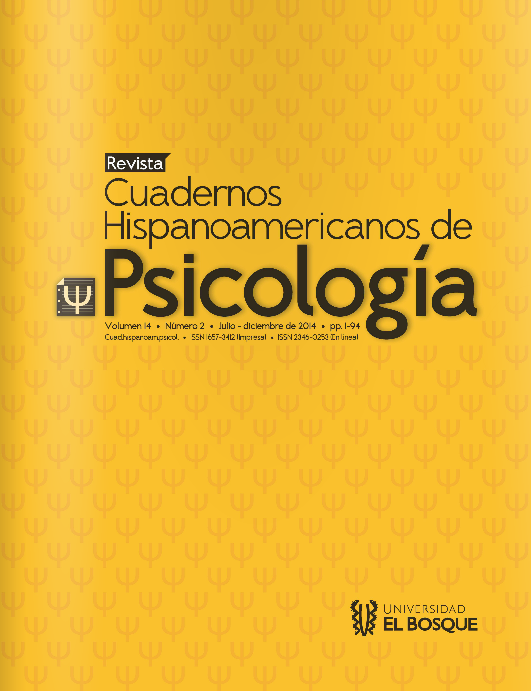Un estudio cualitativo de los factores en torno a la aceptación del dolor físico en pacientes crónicos
DOI:
https://doi.org/10.18270/chps..v14i2.1337Keywords:
Dolor, Dolor, Aceptación, Aceptación, Significado, Significado, Evitación, Evitación, Contingencias, Contingencias, Reforzador y castigo, Reforzador y castigoAbstract
El dolor es la causa más frecuente de consulta médica. La asociación internacional del estudio del dolor (IASP) define el dolor crónico como aquél que puede ser intermitente o continuo y se mantiene por lo menos 3 meses. La persona con dolor crónico se ve afectada a nivel psicológico. El objetivo de este estudio cualitativo de tipo fenomenológico es identificar y analizar los aspectos relacionados con la aceptación (desde el modelo de la terapia de aceptación y compromiso - ACT y la teoría de los marcos relacionales - TMR) del dolor en pacientes crónicos. El método principal fue una entrevista individual semi-estructurada. Los actores de investigación fueron 2 personas de sexo femenino. El análisis se realizó con categorizaciones (NVIVO 10). Se encontró que el significado del dolor varía según la intensidad del malestar e incapacidad percibida.
Downloads
References
Akerblom, S., Perrin, S., Riviano, M. & McCracken, L. (2015). The mediating role of acceptance in multidisciplinary cognitive behavioral therapy for chronic pain. Journal of pain. doi:10.1016/j.copsyc.2014.12.013.
Bohlmeijera, E., Prenger, R., Tall, E. & Cuijpers, P. (2010). The effects of mindfulness-based stress reduction therapy on mental health of adults with a chronic medical disease: A metaanalysis. Journal of Psychosomatic Research, 68, 539-544.
Branstetter-Rost, A., Cushing, C. & Doleh, T. (2009) Personal values and pain tolerance: Does a values intervention add to acceptance? The journal of pain, 10 (8), 887-892.
Breivik H, Collett B, Ventafridda V, Cohen R, & Gallacher D. (2006) Survey of chronic pain in Europe: prevalence, impact on daily life, and treatment. Pain, 10, 287–333.
Cáceres, P. (2003). Análisis Cualitativo De Contenido: Una Alternativa Metodológica Alcanzable. Psicoperspectivas, 2, 53-82.
Cabezas, R., Mejia, F. y Saenz, X. (2009). Estudio epidemiológico del dolor crónico en Caldas, Colombia. Estudios Dolca. Acta Médica Colombiana.
Castro, L. (2011). Modelo integrador en psicopatología: Un enfoque transdiagnóstico. En V.E. caballo, I.C. Salazar y J.A. Carrobles (Eds). Manual de Psicopatología. Madrid: Pirámide.
Cho, S., Heiby, E., McCracken, L., Lee, S. & Moon, D. (2010). Pain-Related Anxiety as a Mediator of the Effects of Mindfulness on Physical and Psychosocial Functioning in Chronic Pain Patients n Korea. The Journal of Pain, 8, 789-797.
Domjan, M. (2010). Principios de aprendizaje y conducta. México: Wadsworth Cengage Learning.
Flick, U. (2004). Introducción a la investigación cualitativa. Argentina: Ediciones Morata.
Gelso, C.J. & Hayes, J. A. (2002). The management of countertransference. En , J.C. Norcross (Ed.) (2002). Psychotherapy Relations that work. (PP. 285-302). Oxford: University Press.
Harrison, A., McCracken, L., Bogosian, A. & Moss-Morris, R. (2015). Towards a better understanding of MS pain: A systematic review of potentially modifiable psychosocial factors. Journal of psychosomatic research, 78, 12-24.
Hayes, S., Levin, M.E., Plumb-Vilardaga, J., Villate, J. & Pistorello, J. (2013). Acceptance and commitment therapy and contextual behavioral science: Examining the progress of a distinctive model of behavioral and cognitive therapy. Behavior therapy, 44, 180-198
Hayes, S. C., Strosahl, K. & Wilson, K. G. (1999). Acceptance and commitment therapy: An experimental approach to behavior change. New York: Guilford Press.
Hayes, S. C., Strosahl, K., Wilson, K. G., Bissett, R. T., Pistorello, J., … Toarmino, D. (2004). Measuring experiential avoidance: A preliminary test of a working model. The Psychological Record, 54, 553−578.
Hass-Cohen, N. & Clyde, J. (2009). Pain, attachmente, and meaning making: Report on an arte therapy relational neuroscience assessment protocol. The Arts in Psychotherapy, 36, 175-184.
Henwood, P., Ellis, J., Logan, J., Duboolouz, C. & D’ Eon, J. (2012). Acceptance of neuropathic pain in spinal cord injured persons: a qualitative approach. Pain management nursing, 13 (4), 215-222.
Kashdan, T. B., & Rottenberg, J. (2010). Psychological flexibility as a fundamental aspect of health. Clincial psychology review, 30, 865-878.
Kozak, A. (2008). Mindfulness in the management of chronic pain: conceptual and clinical considerations. Techniques in Regional Anesthesia and Pain management, 12, 115-118.
Luciano, M.C. y Valdivia, M.S. (2006). La terapia de aceptación y compromiso (ACT). Fundamentos, características y evidencia. Papeles del psicólogo, 22 (2), 79-91.
McCracken, L. & Eccleston, C. (2003). Coping or acceptance: What to do about chronic pain? Pain 105, 197-204.
McCracken, L. & Eccleston, C. (2005). A prospective study of acceptance of pain and patient functioning with chronic pain. Pain, 118, 164-169.
McCracken, L. & Velleman, S. (2010). Psychological flexibility in adults with chronic pain: A study of acceptance, mindfulness, and values-based action in primary care. Pain, 148, 141-147.
McCracken, L.M., Vowles, K.E. & Eccleston, C. (2004). Acceptance of chronic pain: component analysis and a revised assessment method. Pain, 107, 159-166.
McCraken, L., Vowles, K., & Eccleston, C. (2005) Acceptancebased treatment for persons with complex, long standing chronic pain: a preliminary analysis of treatment outcome in comparison to a waiting phase. Behaviour Research and Therapy 43, 1335-1346.
Torrance, N., Elliot, A, Lee, & Smith, B. (2010). Severe chronic pain is associated with 10 year mortality. A cohort recorde linkag study. Eurpean Journal of Pain, 14, 380-386.
Tornero, C., Herrea, J., Molá, O. y Galván, J. (2012). Buprenorfina transdérmica (Feliben®). Nueva opción terapéutica para pacientes con dolor moderado y severo. Revista de la Sociedad Española del Dolor, 19 (6), 301-309.
Viane, I., Crombez, G. Eccleston, C., Devulder, J. & De Corte, W. (2004). Acceptance of the unpleasant reality of chronic pain: effects upon attention to pain and engagement with daily activities. Pain, 112, 282-288.
Vademecum (n.d). Valdemecun. Recuperado el día 24 de noviembre de 2013. http://www.iqb.es/cbasicas/farma/farma04/p072.htm
Vásquez, J. (2010). Pregabalina como opción terapéutica en el tratamiento del dolor neuropático periférico y otras neuralgias. Revista médico-científica luz y vida, 1 (1), 26-30.
Wilson, K. G. y Luciano, M. C. (2008) Terapia de aceptación y compromiso (ACT). Un tratamiento conductual orientado a los valores. Madrid: Pirámide.
Zimmermman, C. (2012). Acceptance of dying: A discourse of palliative care literatura. Social Science & Medicine, 75, 217-224.
Downloads
Published
How to Cite
Issue
Section














